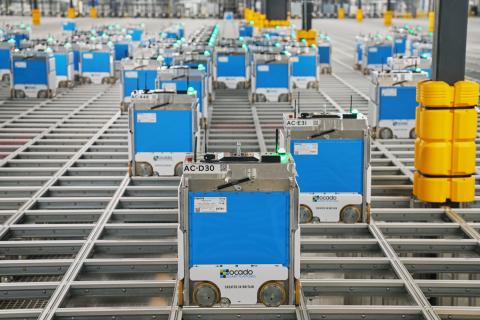Warehouses of the Future

Whether they’re being built from the ground up or retrofitted with next-generation technology, today’s grocery warehouses are going far beyond their humble beginnings. Companies like Ocado and Instacart are bringing unique fulfillment facilities to grocers across the country, while others are providing warehouse orchestration and omnichannel adaptations, as well as necessary facility upgrades and turnkey software solutions.
With some of the country’s largest retailers recently being forced to lay off associates throughout their fulfillment operations in an effort to right-size their operations, and others running into budgetary issues while trying to offer fast and free shipping, optimizing warehouse performance and streamlining delivery networks have never been more important. So, what are some of the country’s leading food retailers doing to get their warehousing in tip-top shape?
[Read more: "Key Strategies for Retailers Facing Online Competition"]
Building on Fulfillment Needs
Earlier this year, San Francisco-based Instacart rolled out its Carrot Warehouse model, through which it offers food retailers individualized warehouse solutions that can offer delivery in as few as 15 minutes. According to the company, Carrot Warehouses are customized for each grocer’s needs, ranging from nano-fulfillment to full-basket grocery, with or without automation.
Lakeland, Fla.-based Publix Super Markets was the first grocer to use the Instacart nano-fulfillment solution, and is now able to offer 15-minute delivery of fresh produce, pantry staples, household goods and more in several Miami neighborhoods. Erik Katenkamp, VP of omnichannel and application development at Publix, explains that the grocer’s move is the next step in its omnichannel strategy.
“Instacart’s model is to empower retailers to better serve their customers,” says Daniel Danker, VP of product at Instacart. “We’re taking the same approach by building Carrot Warehouses, a network of nano-fulfillment facilities that we operate on retailers’ behalf, to help retailers deliver unmatched speed and selection to their customers.”
U.K. online grocer Ocado Group, meanwhile, continues to work alongside the Cincinnati-based Kroger Co. to roll out hub-and-spoke e-commerce fulfillment centers throughout the United States. The 350,000-square-foot highly automated hub facility in Dallas, for example, can fill 18,000 orders a day and was designed to accommodate more than 1,000 robots that traverse large 3D grids to pick food from totes and carry it to an order assembly area. That fulfillment center works in tandem with regional spoke sites in Austin, Texas; San Antonio; and Oklahoma City that serve as last-mile cross-decks to expand and enhance delivery service.
Elsewhere, Walmart recently opened its first co-located fulfillment center at a store in its hometown of Bentonville, Ark. The market fulfillment center (MFC) is built within the store and features a proprietary storage and retrieval system called Alphabot. That system operates inside of a warehouse-style space, using autonomous carts to retrieve ambient, refrigerated and frozen items ordered for online grocery. After it retrieves them, Alphabot delivers the products to a workstation, where a Walmart associate checks, bags and delivers the final order.
“The dedicated space allows us to concentrate on picking items for our online customers,” says Gilbert Giron, an MFC digital team lead at Walmart. “I feel confident that the items our associates are looking for are going to be there when a customer wants them.”

Major Tech Upgrades
A bevy of third-party technology providers, meanwhile, is offering cutting-edge warehouse and fulfillment solutions to grocers of all sizes — without the need to start from scratch. Scottsdale, Ariz.-based Blue Yonder recently unveiled its Warehouse Execution System and Adaptive Fulfillment & Warehousing solutions, both of which promise to dramatically speed up digitalization from warehousing to micro-fulfillment operations, and include features such as holistic resource orchestration, plug-and-play integrations, modular architecture, and scalability.
“From first to last mile, companies need the ability to respond faster while keeping fulfillment time and costs as low as possible,” explains Gurdip Singh, chief product officer at Blue Yonder. “These two new Blue Yonder solutions enable agile and scalable modern-day warehouse and micro-fulfillment operations with seamless, prescriptive workflows and consistently high service at a value-driven cost.”
For its part, Atlanta-based intelligent automation provider Dematic has partnered with Upshop, based in Tampa, Fla., to supply integrated fulfillment solutions that scale with grocery business. The partnership’s aim is to empower grocers looking to grow their fulfillment operations with solutions that allow them to retain and manage their own customer data. With Dematic, Upshop e-commerce fulfillment users can quickly and efficiently implement automation capabilities while keeping their own software foundation.
Additionally, on-demand fulfillment provider Fabric has launched the Fabric Partner Elite Program, a new set of comprehensive resources in coordination with strategic partners to help brands, retailers, grocers and logistics service providers level up their operations to meet consumer expectations. The cost-effective program is designed for brands and retailers looking to implement automation and MFCs to speed up fulfillment and streamline existing supply chain resources.
“Customers and brands don’t agree on what ‘fast fulfillment’ means,” notes Kimberly Barr, global director of partnerships at Tel Aviv-based Fabric. “Customers expect same-day or next-day shipping, but many companies feel their current window of five to seven days is adequate. Retailers who want to meet rising customer expectations are deploying disruptive technologies like Fabric’s MFC solution to meet these demands, all while achieving their profitability and sustainability goals.”

.jpeg?itok=PPwvSWS4)





